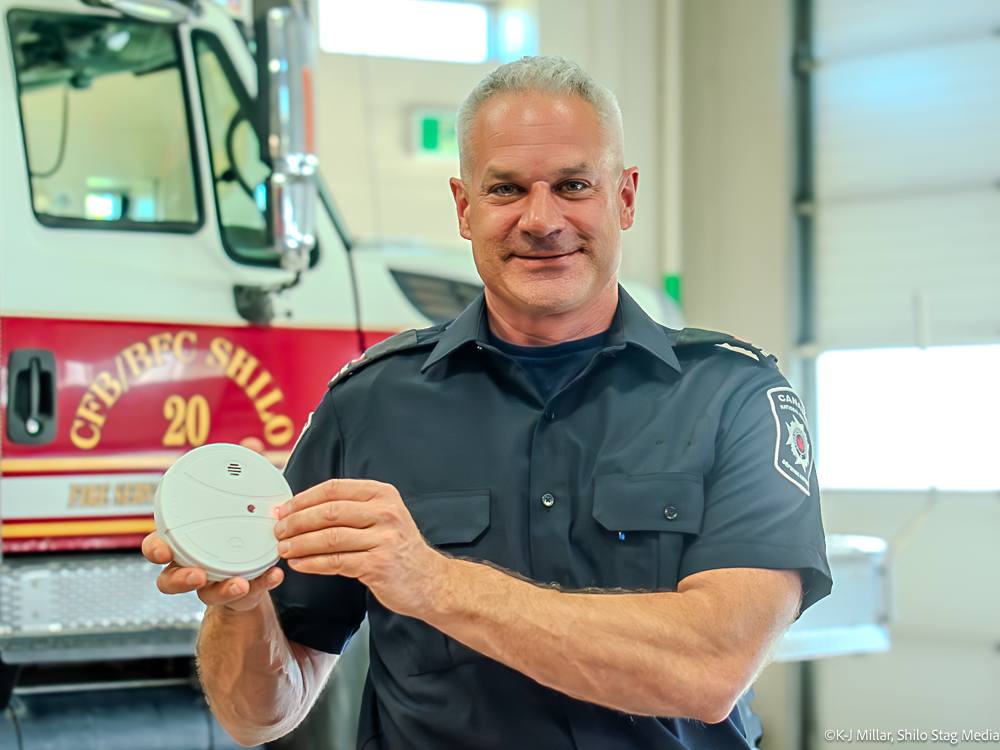
CFB Shilo firefighter Dale DeVlieger explains smoke detectors save lives and need to be tested regularly with the batteries being changed. National Fire Safety Week is from Oct. 6 to 12. (Photo: K-J Millar/Shilo Stag Media)
K-J Millar
Shilo Stag Media
Three out of five fire deaths happen in homes with either no smoke alarms or no working smoke detectors, according to the National Fire Prevention Association (NFPA) at the start of Fire Prevention Week from Oct. 6 to 12.
The theme in 2024 is “Smoke alarms – make them work for you.”
CFB Shilo Fire and Emergency Services is encouraging the public to ensure they have working smoke detectors in their homes with the message “Install, Test, and Replace.”
- INSTALL smoke alarms in every bedroom, outside each seperate sleeping area, eg. hallway, and on each level of the home including the basement.
- TEST smoke alarms at least once a month by pressing the button.
- Replace smoke alarms when they reach 10 years old or stop responding to being tested.
The NFPA offers tips for smoke alarms and carbon monoxide detectors:
A continued set of three loud beeps from the smoke detector means smoke or fire. Get Out. Call 911 and stay out.
A single “chirp” every 30 or 60 seconds means the battery is low and must be changed.
Chirping that continues after the battery has been replaced indicates that the alarm is at the end of its life cycle and must be replaced.
Carbon monoxide detectors:
A continuous set of four beeps mean carbon monoxide is present in your home. get outside and call 911. Stay out.
A single chirp every 30 to 60 seconds means the battery is low and must be replaced.
Carbon monoxide detectors have an end-of-life sound that varies by manufacturer. When heard, it means it’s time to replace the alarm.
Chirping that continues after the alarm has been replaced means the alarm unit needs to be replaced.
“Make sure your smoke and CO alarms meet the needs of everyone in your home, including those with sensory or physical disabilities,” the NFPA website states.
The NFPA advises installing a bedside alert device that responds to the sound of the smoke detectors and CO alarms. A low-frequency alarm can wake a sleeping person with mild to severe hearing loss.
“Sleep with your mobility device, glasses and phone close to your bed. Keep pathways like hallways lit with night lights. Keep the area free from clutter so everyone can get out safely,” the national fire prevention organization states.
One in 10 residential fires occurs in a home without a working smoke detector.
During the six-year period, from 2015 to 2021, Statistics Canada states
death rates were lower in homes with working smoke alarms, where 26 per cent of incidents resulted in death.
“Homes without a working smoke alarm, including those without an installed alarm or the status was unknown, accounted for nearly three out of four deaths or 74 per cent. These statistics highlight the importance of functioning smoke alarms and the potential they have to save lives and prevent injury,” the Stats Can website states.
“For over one-third of the residential fires (38%) that occurred from 2015 to 2021, the status of the fire alarm was unknown, while a similar share had a working smoke alarm (37 per cent). A further 12 per cent had smoke alarms that did not activate and 13 per cent had no smoke alarm installed.”

